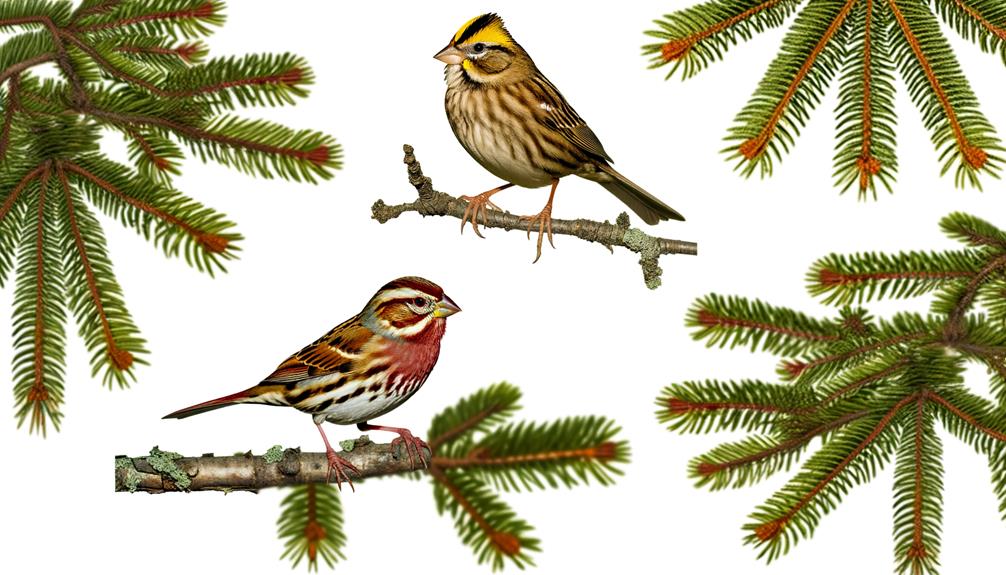10 Key Differences: Golden Crowned Sparrow Vs Fox Sparrow
The Golden Crowned Sparrow and Fox Sparrow differ in size, color, and habitat preference. Golden Crowned Sparrows are medium-sized and sport a distinctive golden-yellow crown, while Fox Sparrows are larger, with russet-colored or gray plumage.
Golden Crowned Sparrows thrive in North America's northern edges, while Fox Sparrows adapt to diverse landscapes from forests to human-altered environments. Both sparrows eat seeds, insects, and berries, their diets varying seasonally.
Each exhibits unique breeding behaviors and songs. Conservationists classify Golden Crowned Sparrows as 'Least Concern', while Fox Sparrows face some population decrease.
Revealing their intriguing life cycle sheds light on these remarkable birds.

Key Takeaways
- Golden Crowned Sparrows have a distinctive golden-yellow crown, while Fox Sparrows have russet-colored plumage.
- Fox Sparrows are larger, ranging from 15 to 21 cm, compared to the medium-sized Golden Crowned Sparrows.
- Both species have varied diets including seeds, insects, and berries, but proportions vary seasonally.
- Golden Crowned Sparrows prefer edges of forests and open shrubs, while Fox Sparrows thrive in diverse environments including dense shrubs and human-altered landscapes.
- Golden Crowned Sparrows are classified as 'Least Concern' by IUCN, whereas Fox Sparrows face population decrease in some areas due to habitat loss.
Golden Crowned Sparrow: Basics
The Golden Crowned Sparrow, a medium-sized songbird native to North America, stands out with its distinctive golden-yellow crown and sweet, melancholic song. It's part of the Emberizidae family, making it a close relative to buntings and American sparrows.
This species, Zonotrichia atricapilla, is primarily found in the western regions of North America. It migrates seasonally, spending winters along the Pacific Coast and summers in Alaska and northwestern Canada.
It's a granivorous bird, primarily feeding on seeds and berries, but it's also known to consume insects. The Golden Crowned Sparrow's nesting habits are also a point of interest, with nests typically placed on the ground or low in bushes.
These basic characteristics make the Golden Crowned Sparrow a fascinating subject of study.
Distinctive Features of Golden Crowned Sparrow
Building on the basics of the Golden Crowned Sparrow, it's time to highlight its distinctive features that set it apart from other songbirds. This bird is named after its most striking feature: a patch of bright yellow feathers on its head, resembling a crown. Its plumage is mainly brown with streaks of gray.
Below is a table that further elucidates on the specific features of the Golden Crowned Sparrow:
| Feature | Description |
|---|---|
| Head Pattern | Bright yellow crown, bordered by black stripes |
| Plumage | Brown overall with gray streaks |
| Size | Medium-sized songbird, approximately 5.5 to 6.3 inches in length |
| Bill | Thick, conical, yellowish-gray |
| Voice | Clear, descending whistles, 'oh-dear-me' song |
These unique traits distinguish the Golden Crowned Sparrow from its fellow avian creatures.
Natural Habitat of Golden Crowned Sparrow
Spanning across varied geographical locations, Golden Crowned Sparrows can often be found inhabiting the edges of forests, thickets, and open shrubs in the northern parts of North America. They're particularly prevalent in Alaska and Canada, where the climate and vegetation suit their needs.
Biologically adapted to cold weather, these sparrows thrive in boreal and temperate zones. Their habitat selection is closely linked with their annual migration patterns. In winter, they migrate southwards, preferring the coastal regions and lowlands of California. The dense shrubbery provides ample cover against predators, while the availability of food sources, despite the season, ensures their persistence.
Understanding their habitat preferences provides key insights into their behavior, adaptability, and survival strategies in varied environmental conditions.
Diet and Feeding Habits of Golden Crowned Sparrow
Diving into the diet and feeding habits of the Golden Crowned Sparrow reveals that these birds primarily sustain themselves on a varied menu of seeds, berries, insects, and plant matter. During the non-breeding season, they exhibit a higher propensity to consume hefty amounts of seeds and berries.
However, their diet changes with the onset of the breeding season. Insects become a critical part of their sustenance during this time, providing essential proteins for reproductive functions. They primarily forage on the ground, often scratching the surface with their feet to uncover hidden food items. They're also observed gleaning from shrubs and low trees.
Their opportunistic nature allows them to adapt their diet based on the availability of food sources.
Golden Crowned Sparrow: Mating and Breeding
In the life cycle of the Golden Crowned Sparrow, mating and breeding play a pivotal role.
The unique rituals during the mating season, the intricate details of their nesting habits, and the survival tactics employed by fledglings provide an insightful snapshot into the species' perpetuation strategies.
Through a scientific lens, each of these aspects will be analyzed, offering a thorough understanding of the Golden Crowned Sparrow's reproductive behavior.
Mating Rituals Explored
When it comes to the Golden Crowned Sparrow's mating rituals, they're quite distinctive and fascinating, with breeding season typically commencing in late spring to early summer.
The males particularly engage in three key behaviors during this period:
- Song performance: Males sing complex and melodious songs to attract females. These songs are unique to each bird, serving as a form of identification.
- Feather fluffing: Males display an extravagant show of fluffing their feathers, often accompanied by a dance, to woo potential mates.
- Food offering: It's common for males to bring food offerings to females as a demonstration of their ability to provide.
These behaviors highlight the Golden Crowned Sparrow's intricate breeding rituals, demonstrating the evolutionary adaptations the species has developed for successful reproduction.
Nesting Habits Unveiled
After securing a mate, the Golden Crowned Sparrow sets out on the critical task of building a nest, a process rooted in instinct and adapted for best survival. The sparrow selects a concealed ground location or low shrubbery, using twigs, grasses, and leaves to construct the nest, often lined with softer materials like feathers for insulation.
This strategic choice of nesting site mitigates exposure to predators and harsh weather conditions. The female typically lays three to five greenish-blue eggs, with dark brown markings. Incubation, primarily by the female, lasts approximately 12-14 days.
This intricate and instinctual process of nest building and egg incubation reveals the Golden Crowned Sparrow's strategic adaptations for successful reproduction and species survival.
Fledgling Survival Tactics
Emerging from the eggs after a two-week incubation period, Golden Crowned Sparrow fledglings display a remarkable array of survival tactics that are essential for their existence in the wild. These fledglings demonstrate an instinctive grasp of survival skills that are both fascinating and intricate.
- Camouflage: The young sparrows' dull, earth-toned feathers blend seamlessly with their natural surroundings, a perfect disguise against predators.
- Silence and Stillness: Fledglings instinctively stay quiet and still when danger is sensed, making them harder to detect.
- Fledging Dispersal: Post-fledging, these birds disperse quickly, reducing the risk of predation on the nest.
These survival strategies, honed over evolutionary timescales, enhance a fledgling's chances of reaching adulthood, highlighting the resilience and adaptability of the Golden Crowned Sparrow.
Fox Sparrow: An Overview
The Fox Sparrow is a songbird of significant ornithological interest. It presents certain distinguishing physical characteristics that aid in its identification.
Its habitats are marked by distinct ecological features, spread across various regions, influencing the bird's behavior and life cycle.
An in-depth examination of these aspects will provide a thorough overview of this species.
Fox Sparrow Identification
One can't help but notice the Fox Sparrow's distinctive features, which include a heavy, conical beak, a long, rounded tail, and a rich, rufous coloration interspersed with gray and brown hues. Its striking plumage is often marked with large, splotchy patterns, a distinctive trait that sets it apart from other sparrows.
To identify a Fox Sparrow, one should pay attention to the following features:
- Beak: Fox Sparrows possess a stout, heavy beak, which is primarily adapted for foraging and cracking seeds.
- Tail: The tail is long, rounded, and usually russet-colored, often flicked or pumped in flight.
- Coloration: They exhibit a rich rufous coloration, punctuated with large, dark spots on the underparts.
These characteristics help in correctly identifying this robust, russet sparrow.
Fox Sparrow Habitats
While many might assume that Fox Sparrows are limited to forested habitats, they're actually quite adaptable, thriving in a variety of environments ranging from dense shrubs and thickets to forest edges and even disturbed human habitats. Their preference for areas with dense understory vegetation, including deciduous and coniferous forests, is notable.
To adapt to human-altered landscapes, they've proven capable of utilizing habitats like gardens, parks, and suburban areas. In winter, they can be found in both rural and urban locations, often congregating at bird feeders.
A detailed analysis of their habitat preference indicates a behavioral flexibility that aids their survival in diverse environments. Their adaptability and resilience make them an interesting subject for further ecological and behavioral studies.
Unique Characteristics of Fox Sparrow
Sporting a unique russet-colored plumage, Fox Sparrows stand out among their avian counterparts due to their distinct markings and robust size. Their heavyset body, combined with a large, rounded head, gives them an imposing presence relative to the other sparrow species.
The Fox Sparrow's unique characteristics can be broken down into three main aspects:
- Coloration: The Fox Sparrow's plumage varies from reddish-brown to gray, with heavily streaked underparts. This coloration provides them with excellent camouflage in their natural habitats.
- Size: They're one of the largest sparrow species, typically measuring around 15 to 21 cm in length.
- Song: Their song is rich and melodious, a complex performance interspersed with clear, whistled notes.
These key features set Fox Sparrows apart, demonstrating their uniqueness within the sparrow family.
Fox Sparrow: Where They Thrive
Regarding habitat, Fox Sparrows are highly adaptable, thriving in a myriad of environments ranging from thickets, brushy woodland edges, and dense undergrowth to open fields and backyard gardens. This adaptability is mainly due to their varied diet, which allows them to exploit different food sources in various ecosystems.
Their preference for dense cover provides them with ample concealment from predators and harsh weather conditions, leading to a wide geographical distribution. During breeding season, they're commonly found in coniferous and mixed forests in the northern regions of North America. In winter, they migrate southwards into subtropical regions.
Their habitat preferences are influenced by the availability of food sources, cover, and nesting sites, allowing them to thrive from Alaska to the deserts of the Southwest.
Feeding Preferences of Fox Sparrow
Regarding diet, Fox Sparrows aren't picky eaters, demonstrating an impressive adaptability when it comes to their food choices. Their dietary habits vary seasonally, driven by food availability and environmental factors. Scientists have observed that their diet consists mainly of seeds, insects, and berries, with the proportions varying depending on the season.
To provide a clearer view, here's a breakdown of the Fox Sparrow's feeding preferences:
- Seeds: These constitute a significant part of their diet, especially in non-breeding seasons when insects are scarce.
- Insects: During breeding seasons, Fox Sparrows increase their insect intake for protein, essential for egg-laying and chick growth.
- Berries: Berries serve as a crucial food source in late summer and fall, providing energy for migration.
Understanding these preferences aids in conservation efforts and habitat management strategies.
Breeding and Nesting Patterns of Fox Sparrow
Turning our attention to the breeding and nesting patterns, it's fascinating to note that Fox Sparrows exhibit a unique mix of monogamy and territoriality. Fox Sparrows usually breed once per year, laying a clutch of 3-5 eggs in a cup-shaped nest built by the female.
Nests are often placed in shrubs or on the ground hidden amongst dense vegetation. The eggs are incubated by the female for about two weeks, with both parents feeding the chicks after hatching.
Notably, Fox Sparrows are quite territorial during breeding season, defending their nesting sites against intruders. This territoriality, coupled with their monogamous nature, underscores the importance they place on protecting their offspring and ensuring reproductive success.
Comparing Vocalizations: Golden Crowned Sparrow Vs Fox Sparrow
When comparing the vocalizations of the Golden Crowned Sparrow and the Fox Sparrow, distinctive patterns and features emerge.
A thorough analysis of these vocal traits can aid not only in species identification, but also in understanding the nuances of avian communication.
This examination will focus primarily on the unique song patterns, the distinctive vocal features, and the contrasting elements in the vocalizations of these two sparrow species.
Identifying Sparrow Song Patterns
How do the song patterns of the Golden Crowned Sparrow differ from those of the Fox Sparrow?
The Golden Crowned Sparrow's song exhibits a clear, whistling pattern, often described as plaintive or melancholic.
This is contrasted by the Fox Sparrow's song, which is characterized by a rich, complex melody, often interspersed with rapid trills.
The Golden Crowned Sparrow's song usually consists of three notes, descending in pitch, with the second note often the lowest.
The Fox Sparrow, on the other hand, has a song that's a medley of notes and trills, with no clear or consistent pattern.
Lastly, the Golden Crowned Sparrow's song is simpler and slower while the Fox Sparrow's song is faster and more varied.
These variations in song patterns provide fascinating insights into the unique acoustic behaviors of these two sparrow species.
Distinctive Sparrow Vocal Features
While their songs may differ, both the Golden Crowned Sparrow and the Fox Sparrow exhibit unique vocal features that set them apart in the bird kingdom. The Golden Crowned Sparrow's song is a simple, plaintive whistle, typically composed of three descending notes. Its sound is distinctly melancholic, evoking the image of lonely, vast landscapes.
The Fox Sparrow, on the other hand, possesses a rich, melodious song, characterized by a rapid sequence of notes and trills. It's a complex tune, strikingly different from the Golden Crowned Sparrow's, filled with a joyous, lively spirit. These vocalizations, shaped by both genetic factors and environmental influences, contribute to the distinctive identities of these species, and play an essential role in mating rituals and territorial disputes.
Vocalization Differences: Analysis
In analyzing the vocalizations of the Golden Crowned Sparrow and the Fox Sparrow, one can't help but notice the stark contrast in their melodies and the varying emotional tones they evoke.
- Golden Crowned Sparrow: This bird's song is a simple, clear whistle. It consists largely of three descending notes, often transcribed as 'oh-dear-me'. This plaintive melody can evoke a sense of melancholy in the listener.
- Fox Sparrow: The song of the Fox Sparrow is a loud, enthusiastic performance. It's a complex mixture of rich notes, trills, and rapid-fire sequences. This melody typically has a joyful, lively tone.
- Comparison: The Golden Crowned Sparrow's song seems more mournful and the Fox Sparrow's is more exuberant. These differences could be attributed to variations in their natural habitats, behavioral patterns, or genetic predispositions.
Conservation Status: Golden Crowned Sparrow Vs Fox Sparrow
The conservation status of the Golden Crowned Sparrow shows it's classified as 'Least Concern' by the International Union for Conservation of Nature (IUCN), while the Fox Sparrow, though not endangered, has seen some decrease in population in certain areas. This status is determined based on in-depth analysis of population trends, habitat condition, and potential threats.
The Golden Crowned Sparrow's wide range and adaptable nature contribute to its stability. Conversely, the Fox Sparrow faces challenges due to habitat loss, particularly in urban areas, leading to its declining numbers. While not currently threatened, these trends suggest that more attention should be paid to the Fox Sparrow's conservation.
Both species are essential indicators of ecosystem health, hence their preservation is of paramount importance.
Conclusion
To sum it up, both the golden crowned sparrow and the fox sparrow are enchanting avian wonders. Like two sides of a coin, they share similar habits but boast distinct features. Their vibrant calls are music to our ears, echoing the harmony of nature.
However, with fluctuating conservation statuses, it's a stark reminder that we must secure their melodies continue to resonate in our wild spaces, safeguarding their ecological roles and enhancing our natural soundscapes.






